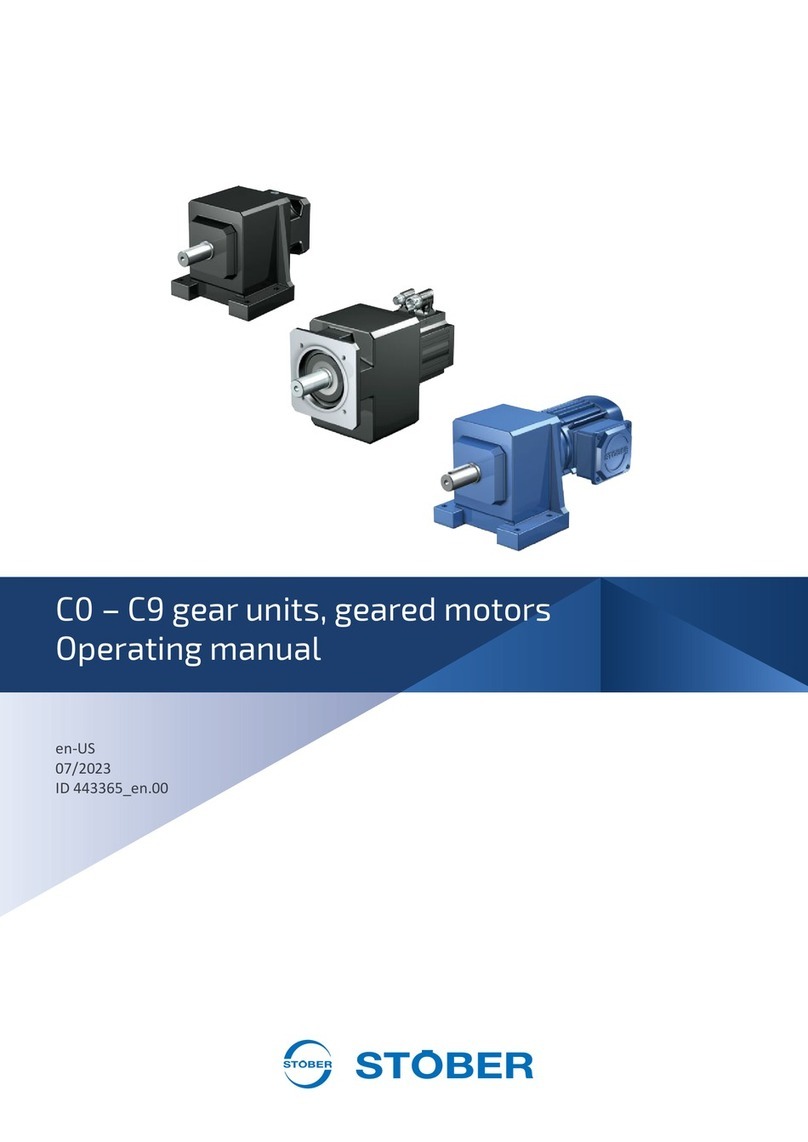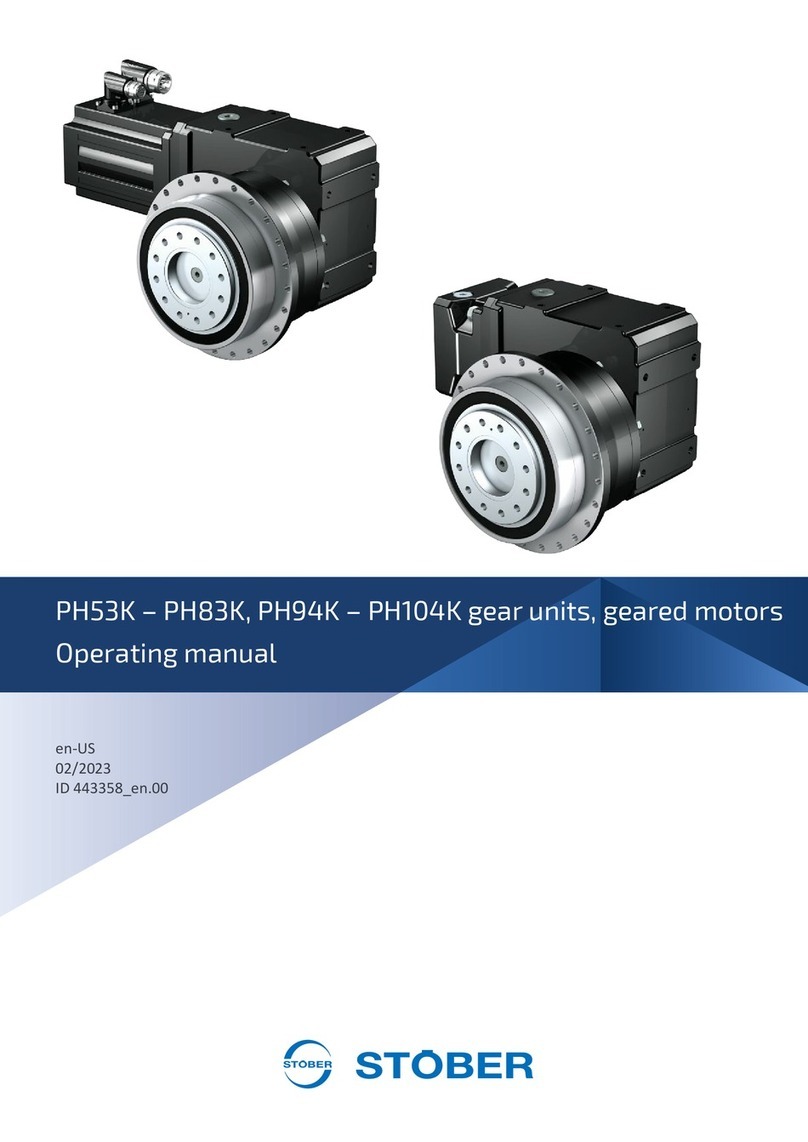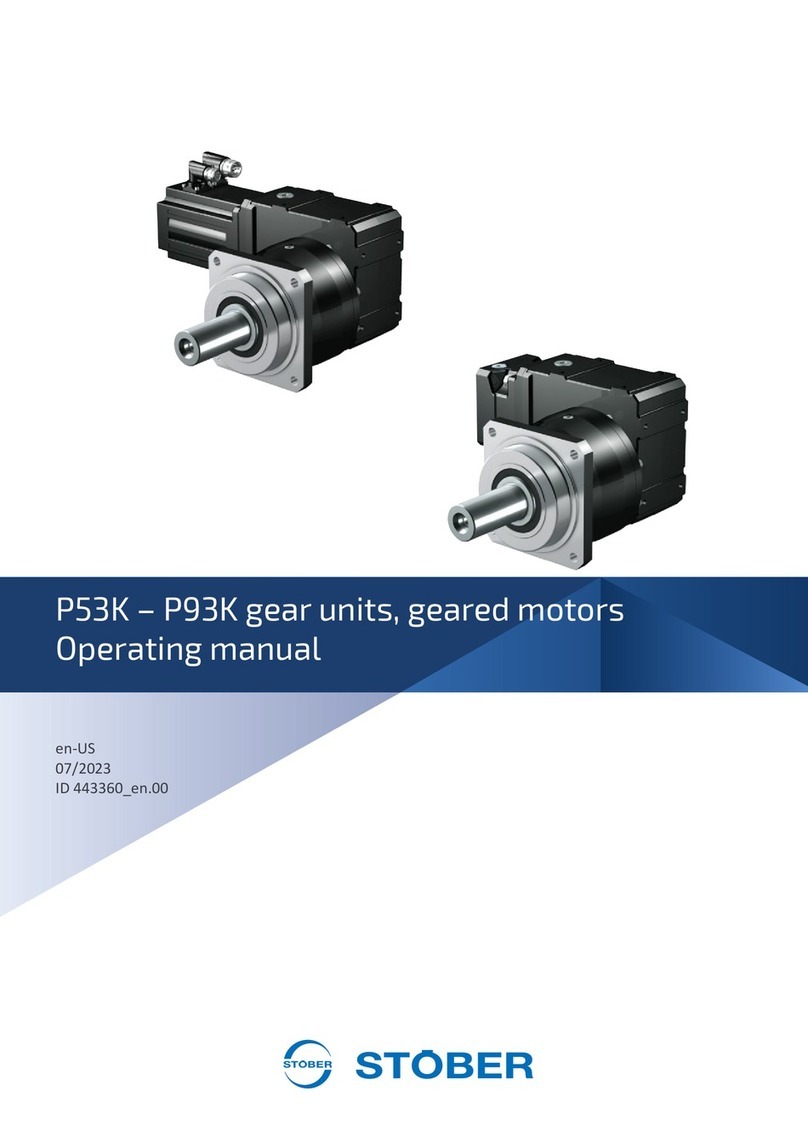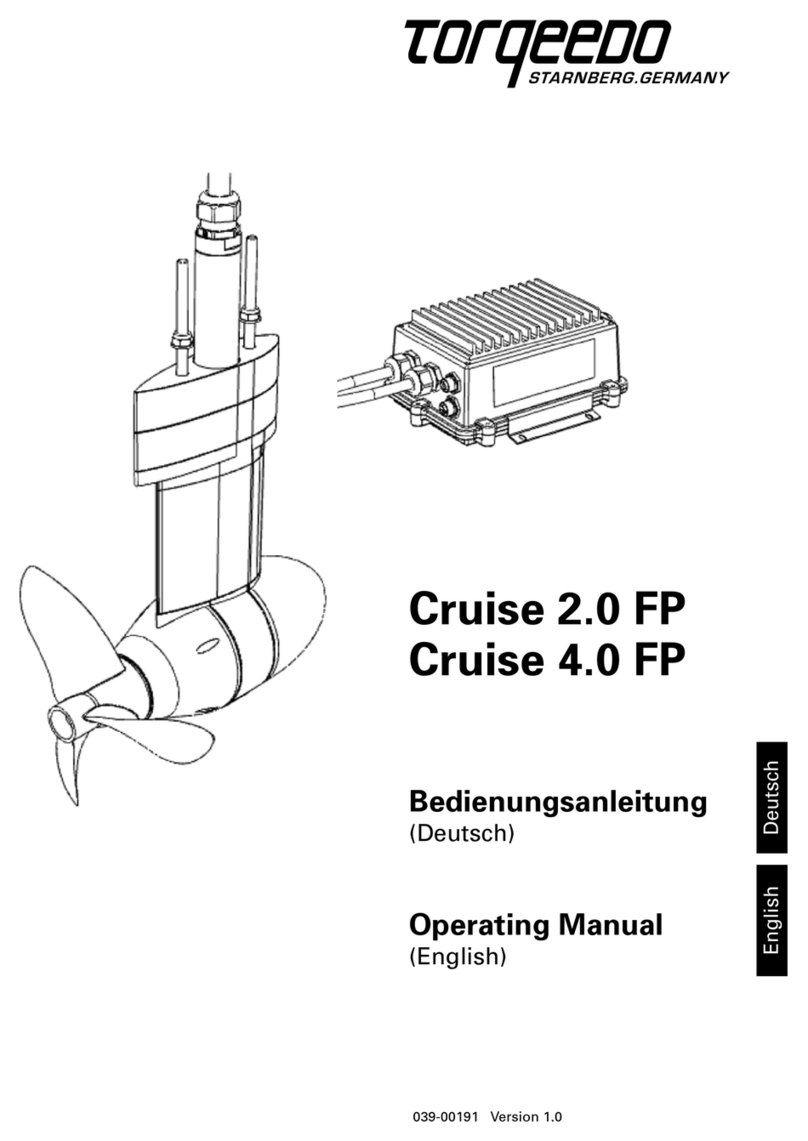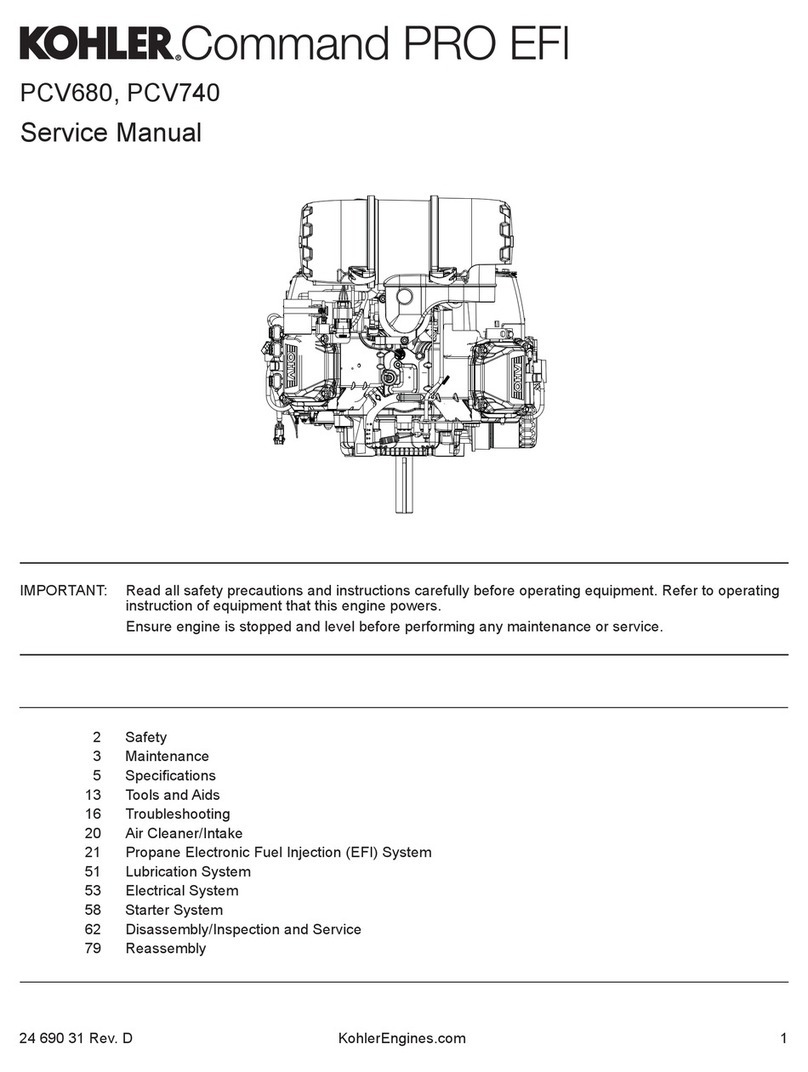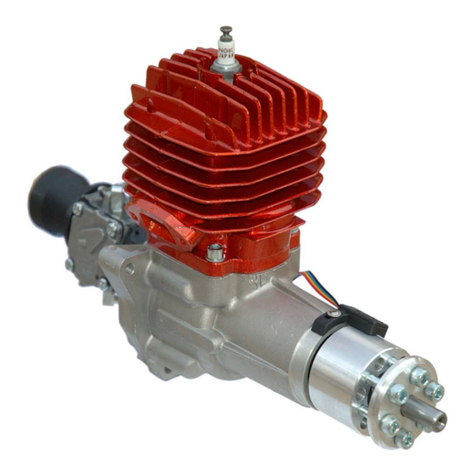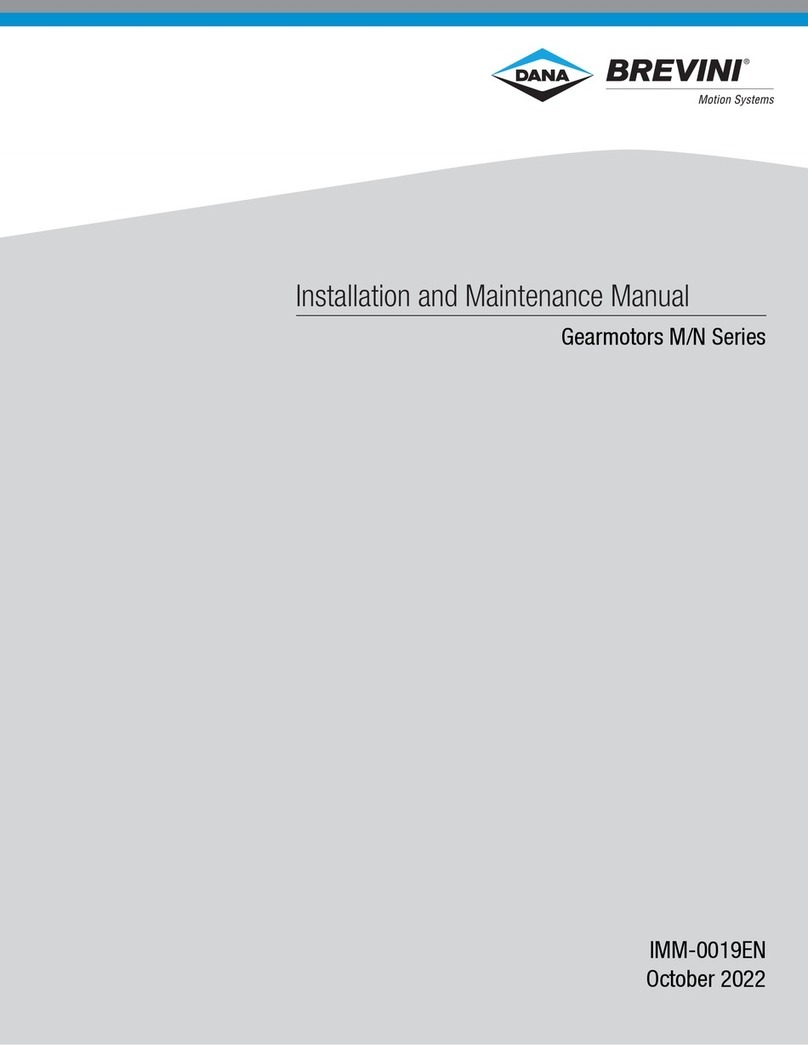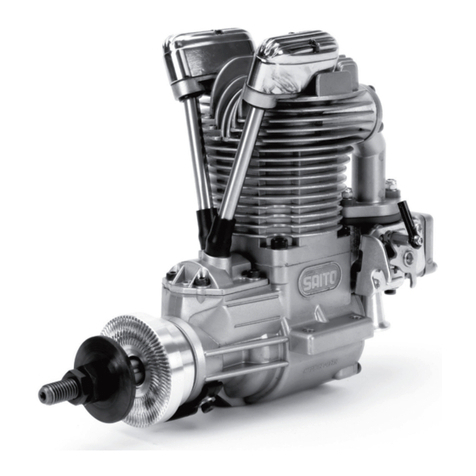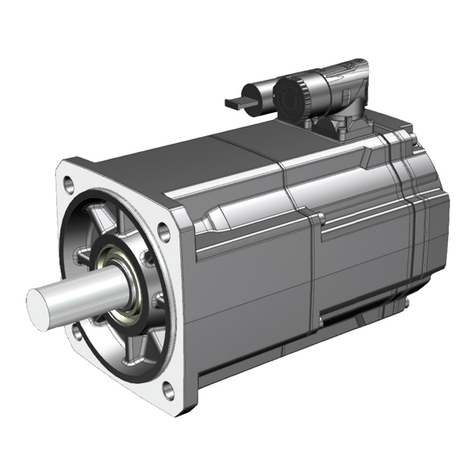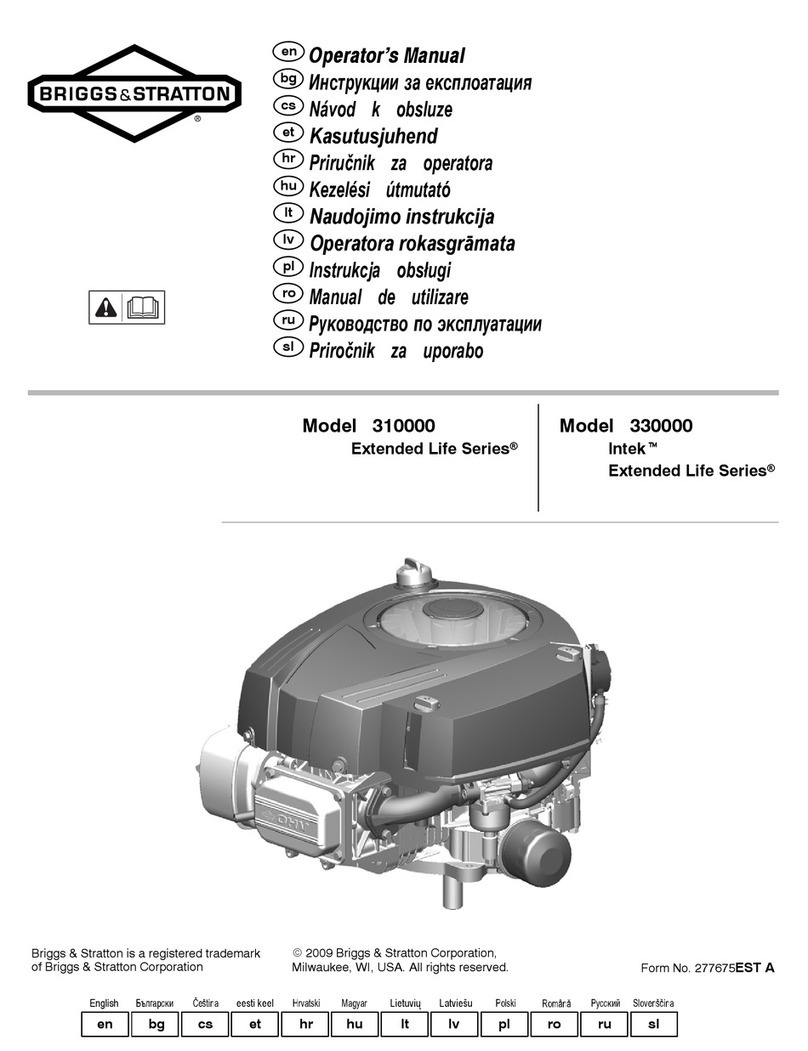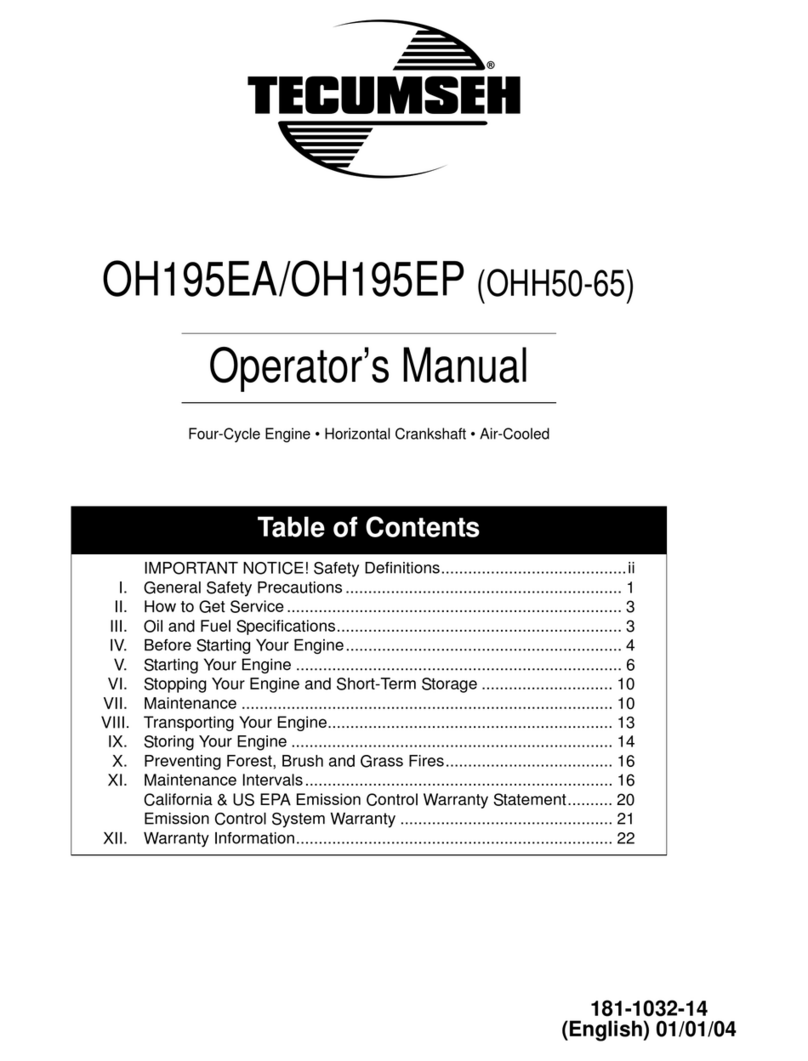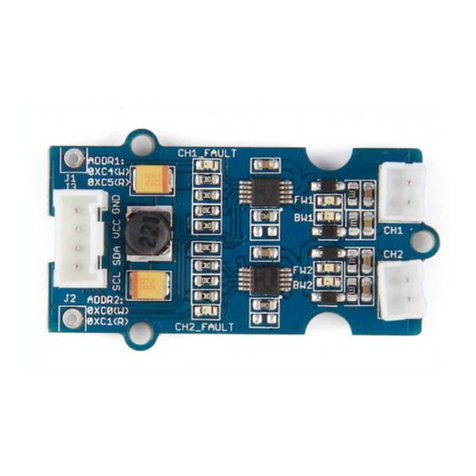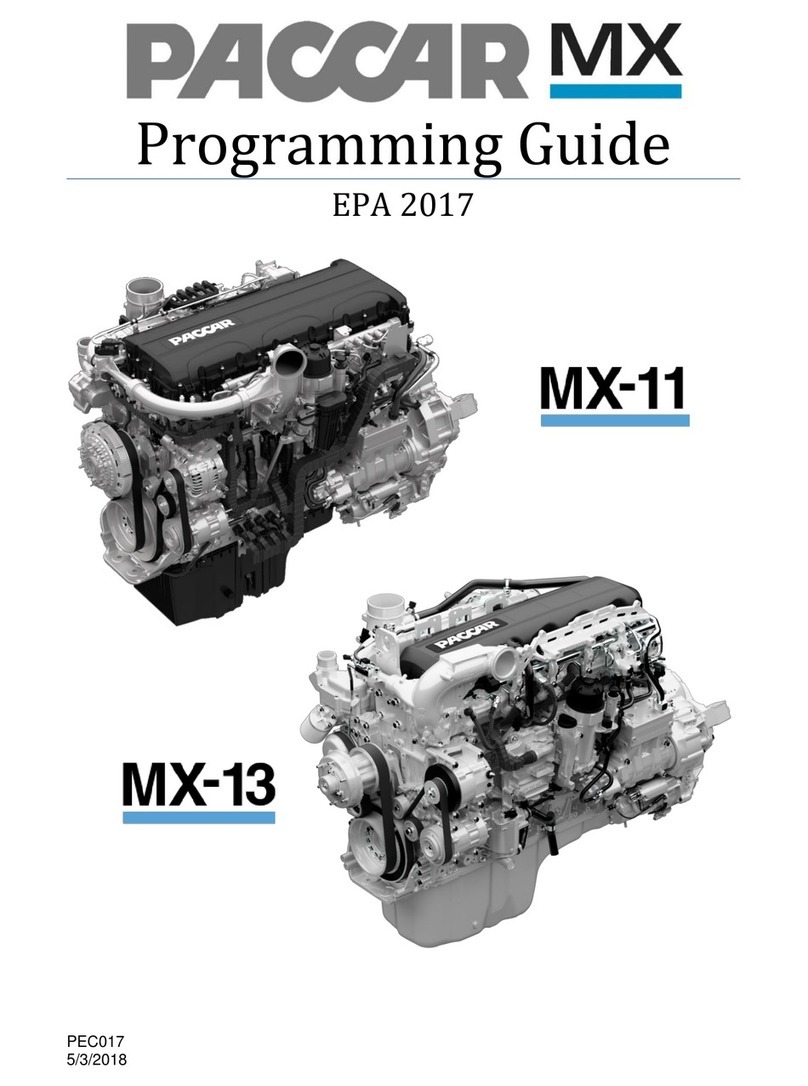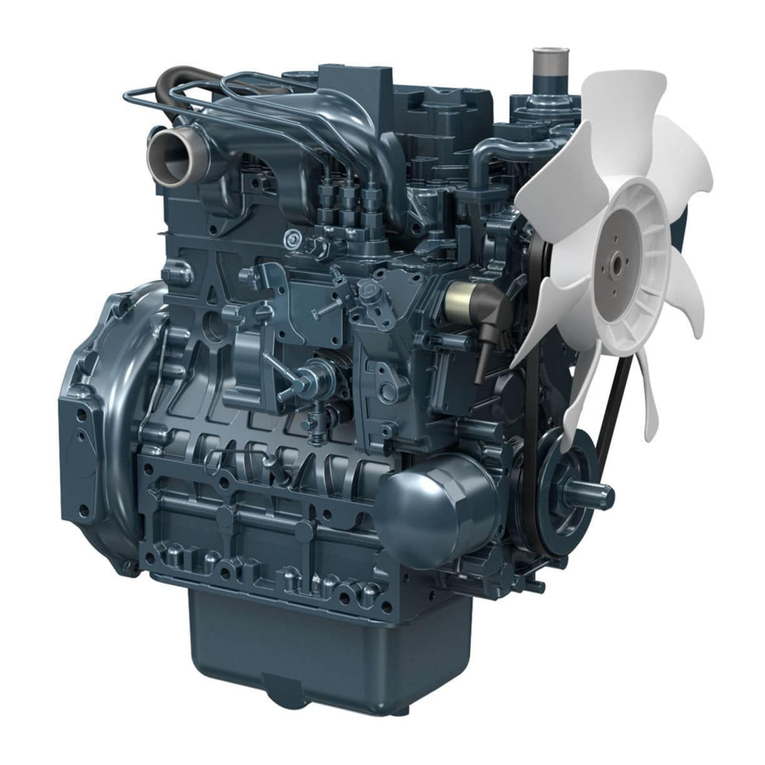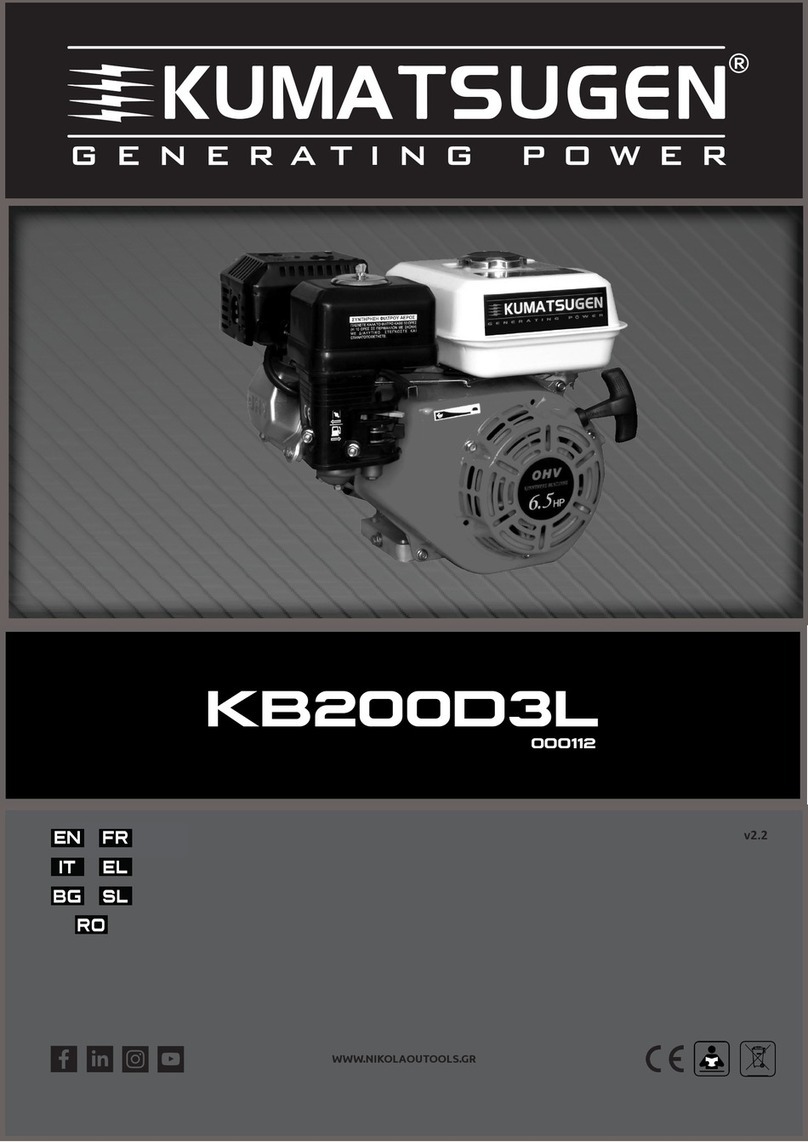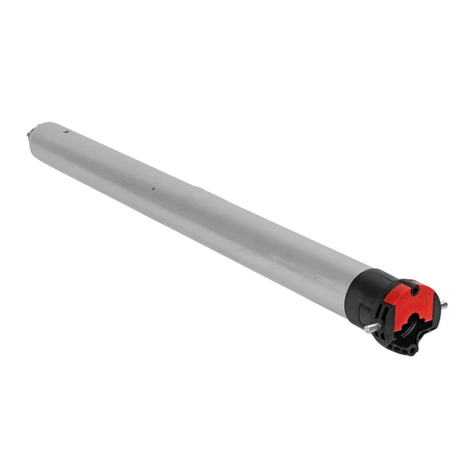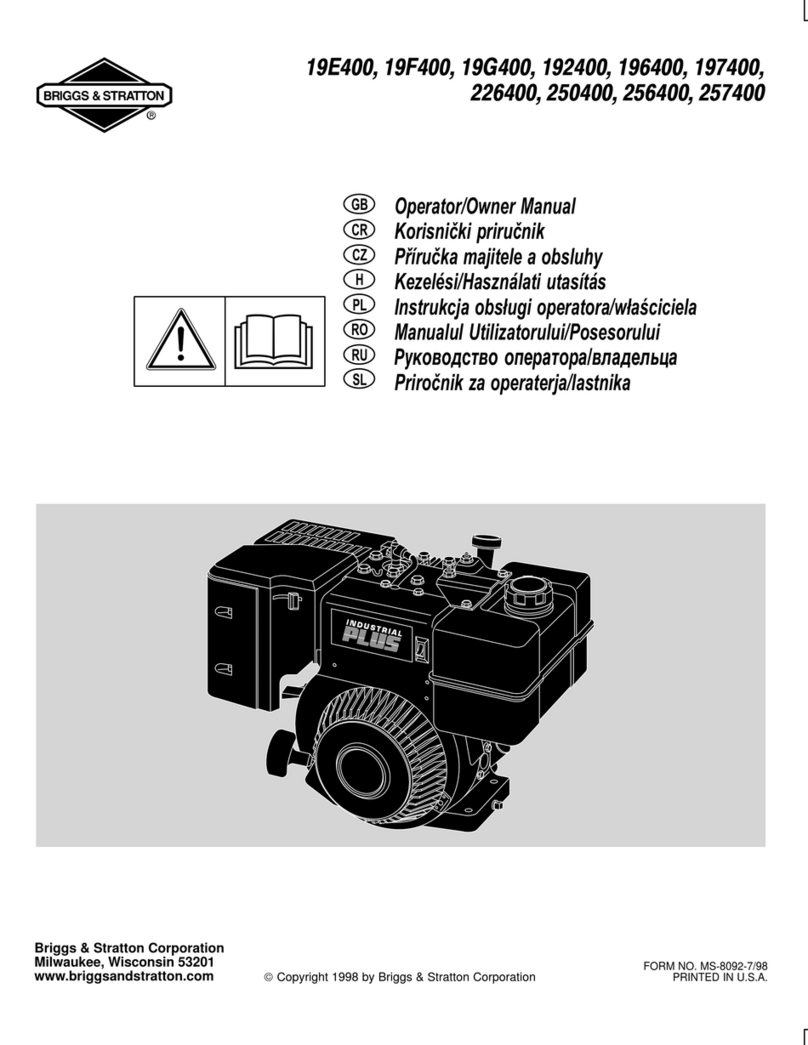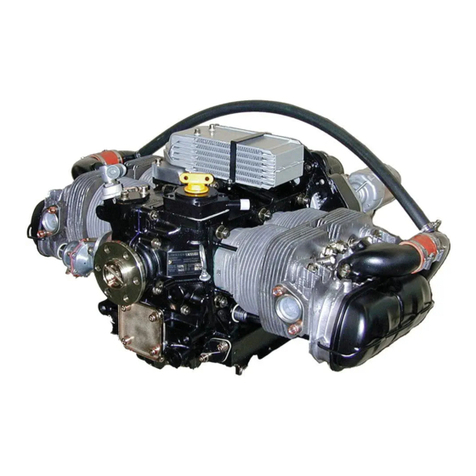Stober PH33KX User manual

PH33KX – PH83KX, PH94KX – PH104KX gear units, geared motors
Operating manual
en-US
02/2023
ID 443359_en.00

Table of contents
2
02/2023 | ID 443359_en.00
Table of contents
1 User information....................................................................................................................................................... 4
1.1 Storage and transfer................................................................................................................................................ 4
1.2 Original language..................................................................................................................................................... 4
1.3 Formatting conventions .......................................................................................................................................... 4
1.4 Terms....................................................................................................................................................................... 5
1.5 Supporting documents ............................................................................................................................................ 5
1.6 Limitation of liability................................................................................................................................................ 5
1.7 Product names and brands...................................................................................................................................... 5
1.8 Copyright notice ...................................................................................................................................................... 5
2 General safety instructions........................................................................................................................................ 6
2.1 Intended use............................................................................................................................................................ 6
2.2 Requirements for personnel.................................................................................................................................... 6
2.3 Prevention of personal injury .................................................................................................................................. 6
2.3.1 Mechanical hazards ................................................................................................................................ 6
2.3.2 Thermal hazards ..................................................................................................................................... 7
2.4 Prevention of property damage .............................................................................................................................. 7
3 Product description................................................................................................................................................... 8
3.1 Basic structure......................................................................................................................................................... 8
3.2 Type designation ..................................................................................................................................................... 9
3.3 Nameplate ............................................................................................................................................................... 9
3.4 Mounting positions ............................................................................................................................................... 10
3.5 Direction of rotation.............................................................................................................................................. 11
3.6 Reverse operation ................................................................................................................................................. 11
3.7 Ambient conditions ............................................................................................................................................... 12
3.8 Other product features.......................................................................................................................................... 12
3.9 Additional documentation..................................................................................................................................... 12
4 Transport and storage ..............................................................................................................................................13
4.1 Transport ............................................................................................................................................................... 13
4.2 Storage .................................................................................................................................................................. 13
4.2.1 Long-term storage ................................................................................................................................ 13
5 Installation...............................................................................................................................................................15
5.1 Cleaning agent and solvent ................................................................................................................................... 15
5.2 Mounting the motor on a gear unit....................................................................................................................... 15
5.2.1 Permitted tilting torques at the gear unit input ................................................................................... 16
5.2.2 Tolerances for the add-on motor ......................................................................................................... 16

Table of contents
02/2023 | ID 443359_en.00
3
5.2.3 Mounting the motor on a gear unit...................................................................................................... 17
5.3 Mounting drive elements on a flange shaft .......................................................................................................... 20
5.4 Mounting the gear unit on the machine ............................................................................................................... 21
5.5 Tightening torques ................................................................................................................................................ 22
6 Commissioning.........................................................................................................................................................23
6.1 Before commissioning ........................................................................................................................................... 23
6.2 During commissioning ........................................................................................................................................... 23
7 Servicing ..................................................................................................................................................................24
7.1 Cleaning................................................................................................................................................................. 24
7.2 Inspection .............................................................................................................................................................. 24
7.3 Remedying faults................................................................................................................................................... 25
7.3.1 Troubleshooting faults.......................................................................................................................... 25
7.4 Servicing ................................................................................................................................................................ 25
7.5 Service ................................................................................................................................................................... 26
8 Removal and disposal...............................................................................................................................................27
8.1 Removal................................................................................................................................................................. 27
8.2 Disposal ................................................................................................................................................................. 27

1 | User information
4
02/2023 | ID 443359_en.00
1 User information
This documentation is a part of the product. It applies to products in the standard design according to the corresponding
STOBER catalog.
1.1 Storage and transfer
As this documentation contains important information for handling the product safely and efficiently, it must be stored in
the immediate vicinity of the product until product disposal and be accessible to qualified personnel at all times.
Also pass on this documentation if the product is transferred or sold to a third party.
1.2 Original language
The original language of this documentation is German; all other language versions are derived from the original language.
1.3 Formatting conventions
Orientation guides in the form of signal words are used to emphasize specific information so that you are able identify it in
this documentation quickly.
Safety notes indicate special risks when handling the product and are accompanied by relevant signal words that express
the extent of the risk. In addition, warning notes for possible property damage and useful information are also indicated by
signal words.
WARNING!
Warning
This word with a warning triangle means there may be a considerable risk of fatal injury
▪ if the stated precautionary measures are not taken.
CAUTION!
Caution
This word with a warning triangle indicates that minor personal injury may occur
▪ if the stated precautionary measures are not taken.
ATTENTION!
Attention
This indicates that damage to property may occur
▪ if the stated precautionary measures are not taken.
Information
Information indicates important information about the product or serves to emphasize a section in the documentation that
deserves special attention from the reader.

1 | User information
02/2023 | ID 443359_en.00
5
Embedded warning information
Embedded warning information is integrated directly into the instruction manual and is structured as follows:
SIGNAL WORD! Type of hazard, its cause and possible consequences of disregarding it! Measures for avoiding the hazard.
Signal words in embedded warning information have the same meaning as in the normal warning information described
previously.
1.4 Terms
This documentation describes both STOBER gear units and gear components of STOBER geared motors. For reasons of
clarity, the collective term drives is used for these.
1.5 Supporting documents
Separate documents apply to the drive components which can be attached to STOBER gear units, depending on the design.
These documents can be found by entering the serial number of the gear unit at https://id.stober.com or by scanning the
QR code on the nameplate of the gear unit.
Alternatively, you can find supporting documents at http://www.stoeber.de/en/downloads/. Enter the ID of the
documentation in the Search... field:
Drive components Operating manual ID
EZ synchronous servo motor 443032_en
1.6 Limitation of liability
This documentation was created taking into account the applicable standards and regulations as well as the current state of
technology.
No warranty or liability claims for damage shall result from failure to comply with the documentation or from use that
deviates from the intended use of the product. This is especially true for damage caused by individual technical
modifications to the product or the project configuration and operation of the product by unqualified personnel.
1.7 Product names and brands
Product names that are registered as brands are not specifically identified in this documentation. Existing property rights
(patents, trademarks, protection of utility models) are to be observed.
1.8 Copyright notice
Copyright © STOBER. All rights reserved.

2 | General safety instructions
6
02/2023 | ID 443359_en.00
2 General safety instructions
There are risks associated with the product described in this documentation that can be prevented by complying with the
described warning and safety instructions as well as the included technical rules and regulations.
2.1 Intended use
The drives described in this documentation are intended for installation in industrial machines or systems.
The following are considered non-intended use:
§Any overloading of the drives
§Operation in ambient conditions that deviate from those described in the corresponding technical documentation
§Modifying or refitting the drives
§Using the drives for an application other than that defined during project configuration
Commissioning the machine in which the drives are installed is prohibited until it has been determined that the machine
corresponds to regional laws and guidelines. In particular, the (Machinery) Directive 2006/42/EC is to be observed in the
respective scope.
Operation of the drives in potentially explosive atmospheres is prohibited, unless they are expressly designed for this.
2.2 Requirements for personnel
All mechanical tasks that arise during the assembly, commissioning, maintenance and removal of the product may be
performed only by specialized personnel who hold a corresponding qualification in the field of metal technology.
All electrical tasks that arise during the assembly, commissioning, maintenance and removal of the product may be
performed only by electrically skilled persons who hold a corresponding qualification in the field of electrical engineering.
Tasks that arise during transport, storage and disposal may be performed by personnel who have been instructed in the
suitable method for doing so.
Furthermore, personnel who handle the product must carefully read, understand and observe the valid regulations, legal
requirements and applicable basic rules as well as this documentation and the safety instructions it contains.
2.3 Prevention of personal injury
2.3.1 Mechanical hazards
WARNING!
Dangerous movements of machine parts!
Moving machine parts can cause serious injuries or even death!
üBefore starting the motor or drive:
▪ Install all protective devices necessary for operation.
▪ Make sure that no one is standing in the danger area or able to enter it unchecked.
▪ Leave the danger area.

2 | General safety instructions
02/2023 | ID 443359_en.00
7
WARNING!
Sinking or falling of gravity-loaded axes or vertical axes after switching off the motor due to gravity!
Falling gravity-loaded axes or vertical axes can cause serious injuries or even death!
▪ Be aware that the holding brake of the motor does not offer sufficient safety for persons that are in the hazard area
of gravity-loaded axes or vertical axes.
▪ Move gravity-loaded axes or vertical axes to their lowest position and lock or brace them mechanically before
allowing people to enter the danger area.
WARNING!
Unsecured feather keys or drive elements can be thrown due to the rotation of the input shaft!
Flying metal parts can cause serious injuries!
▪ Mount the provided drive elements properly or remove them before a test run.
2.3.2 Thermal hazards
CAUTION!
The surface of the drive can reach temperatures over 65°C during operation!
Touching the hot surface of the drive can cause severe skin burns!
▪ Do not touch the drive during operation or immediately afterward.
▪ Allow the drive to cool sufficiently before carrying out work on the drive.
▪ Wear protective gloves when working on the drive.
2.4 Prevention of property damage
ATTENTION!Damage to bearings and shafts due to improper assembly! Never use force when installing machine elements
with fittings, e.g. hitting power transmission elements, shafts or the motor or gear housing with a hammer, but rather
install them in accordance with the following instructions.
ATTENTION!Shaft seal rings can be damaged by solvents! Prevent shaft seal rings from coming into contact with solvents
when cleaning and degreasing unpainted surfaces.

3 | Product description
8
02/2023 | ID 443359_en.00
3 Product description
In this chapter, you can find product details that are relevant for assembly, commissioning and maintenance. Detailed
technical data on your gear unit/geared motor can be found in the order confirmation. You will find more product
information and dimensional drawings in the corresponding catalog (Additional documentation [}12]). The respective
separate technical documentation applies to the attached motors.
3.1 Basic structure
1 Flange shaft 2 Output flange
3 Gear housing 4 Nameplate
5 ME motor adapter

3 | Product description
02/2023 | ID 443359_en.00
9
3.2 Type designation
In this chapter, you can find an explanation of the type designation of the drive.
Example code
PH 7 3 1 S F S S 0050 KX701VF 0010 MF
Explanation
Code Designation Design
PH Type Planetary gear unit
7Size 7 (example)
3
4
Generation Generation 3
Generation 4
1
2
Stages Single-stage
Two-stage
SHousing Standard
FShaft Flange shaft
S
V
Bearing Standard bearing
Reinforced bearing (PH3 − PH5)
S
R
Backlash Standard
Reduced (PH3 − PH9)
0050 Transmission ratio of output
(i x 10)
i = 5 (example)
KX701
VF
Input KX7 right-angle geared motor (example)
0010 Transmission ratio of input
(i x 10)
i = 1 (example)
MF
EZ
Motor adapter
Motor
Motor adapter with FlexiAdapt coupling
EZ synchronous servo motor
3.3 Nameplate
An example nameplate for the gear unit types listed above is explained in the figure below.
23/04STÖBER Antriebstechnik GmbH + Co. KG
Kieselbronner Str. 12, 75177 Pforzheim, DE
SN: 10328934 CD: 8341213
i=60,000; 130/165/38; HCE 150H1; 0,185/0,390 l
PH731SFSS0050KX701VF0010MF
Made in
Germany
1
2
345678910

3 | Product description
10
02/2023 | ID 443359_en.00
Code Designation
1 Name of manufacturer
2 Type designation
3 Gear ratio of the gear unit
4 Serial number of the gear unit
5 Dimensions of the motor adapter (diameter of pilot/bolt circle/motor shaft)
6 Customer-specific data
7 Lubricant specification
8 Lubricant fill volume (PH gear unit/KX gear unit)
9 Date of manufacture (year/calendar week)
10 QR code (link to product information)
3.4 Mounting positions
STOBER coordinates the lubricant fill volume and structure of the gear unit types listed above to the mounting position of
the gear unit in the machine. The mounting position of a gear unit is determined upon ordering and specified in the order
documents.
The standard mounting positions are illustrated below.
The numbers identify the gear unit sides. The mounting position is defined by the gear unit side facing downwards.
EL1 EL2 EL3
EL4 EL5 EL6

3 | Product description
02/2023 | ID 443359_en.00
11
An adhesive label is applied to the gear unit that explains the designated mounting position. The arrow on the adhesive
label indicates the side with which the gear unit must be mounted facing down.
Fig.1: Adhesive label for the mounting position
3.5 Direction of rotation
PH3KX_ − PH5KX_ PH7KX_ − PH10KX_
The pictures show mounting position EL1.
3.6 Reverse operation
To ensure lubrication for circulating gearing parts during cyclic reverse operation from ±20°to ±90° at the output, pay
careful attention to the position of the output shaft for the horizontal mounting of the gear unit, as shown in the diagrams
below.
The images show the center position of reverse operation.
Cyclic reverse operation ≤±20° on request.
Size 3 − 10
1 Position of the mark: bottom
Please note that the hole pattern may be different, depending on the size of the planetary gear unit.

3 | Product description
12
02/2023 | ID 443359_en.00
3.7 Ambient conditions
Standard ambient conditions for transport, storage and operation of the gear unit are described in this chapter. Deviating
ambient conditions for special designs are specified in the order confirmation. Ambient conditions for motors attached to a
gear unit can be found in the technical documentation of the motor.
Feature Description
Transport/storage surrounding temperature −10 °C to +50 °C
Surrounding operating temperature 0 °C to +40 °C
Installation altitude ≤ 1000 m above sea level
Notes
In order to prevent corrosion damage and damage to the shaft seal rings, protect the drive from the following influences:
§Environments with harmful oils, acids, gases, vapors, dust or radiation
§Extreme temperature fluctuations with high humidity
§Condensation or icing
§Strong UV radiation (e.g. direct sunlight)
§Presence of salt spray
§Sparks
In potentially explosive atmospheres, only gear units in an explosion-proof design in accordance with (ATEX) Directive
2014/34/EU may be used. Separate documentation applies to the explosion-proof design.
3.8 Other product features
Other features of gear units in the standard design can be found in the following table.
Feature Description
Maximum permitted gear unit temperature (on the surface
of the gear unit)
≤ 90°C
Paint Black RAL 9005
Lubricant Synthetic; for specification and quantity, see nameplate
Ventilation Gear housing closed on all sides, no ventilation provided
Weight See order documents
Protection class IP65
With a geared motor, keep in mind that the motor protection class may be lower.
3.9 Additional documentation
You will find more information about the product at http://www.stoeber.de/en/downloads/. Enter the ID of the
documentation in the Search... field.
Product combination Catalog title ID
Gear unit + ME/MEL/MF/MFL motor adapter Servo gear units 443054_en
Gear unit + EZ synchronous servo motor EZ synchronous servo geared motors 442437_en
If you have questions about your drive that are not answered by this documentation, please contact STOBER Service
(Service [}26]).

4 | Transport and storage
02/2023 | ID 443359_en.00
13
4 Transport and storage
STOBER products are packaged carefully and delivered ready for installation. The type of packaging depends on the product
size and the transport method.
Observe the following information during transport and storage:
§Inspect the delivery for any transport damage immediately upon receiving it and report any transport damage
immediately. Do not put damaged products into operation.
§Check your delivery for completeness using the delivery note and report any missing parts to the supplier.
§Transport and store the product in the original packaging in order to protect it from damage. Remove the original
packaging and transport safety devices shortly before assembly.
Ambient conditions
The ambient conditions for transport and storage can be found in the chapter Ambient conditions [}12].
4.1 Transport
WARNING!
Suspended loads!
Loads that become loose and fall during the lifting process can cause serious injuries or even death!
▪ Observe the following instructions.
▪ Cordon off the danger zone and ensure that no one stands under the suspended loads.
▪ Wear safety shoes.
Lifting and transporting the drive may require lifting gear (e.g. a crane), depending on the weight. The weight of your drive
is specified in the accompanying delivery documents.
Lift and transport the drive as follows:
§Use lifting gear with a sufficient lifting capacity for the weight of the drive.
§Run hoist slings directly around the drive housing and secure the hoist slings from slipping.
In order to prevent the drive from falling or getting damaged during transport, observe the following:
§Do not lift or fasten the drive on the output shaft or attached parts.
§Fasten the motor installed on the gear unit as well and make sure that there is no diagonal pull.
4.2 Storage
Store the drive in a dry, dust-free environment in the original packaging at a storage temperature between −10°C and
+50°C.
4.2.1 Long-term storage
If you would like to store the drive for longer than 6 months, take the following steps to prevent corrosion damage:
1. Apply a suitable corrosion protection agent to unpainted surfaces, such as shaft ends or flange contact surfaces.
2. Completely fill the gear unit with lubricant. The lubricant specification can be found by entering the serial number of
the gear unit at https://id.stober.com or by scanning the QR code on the nameplate of the gear unit.

4 | Transport and storage
14
02/2023 | ID 443359_en.00
Before commissioning the gear unit, reduce the lubricant fill volume to the fill volume that is specified on the nameplate of
the gear unit.

5 | Installation
02/2023 | ID 443359_en.00
15
5 Installation
This chapter contains information on how to correctly mount standard STOBER drive designs and avoid injury to persons or
damage to property. Differing information for customer-specific designs is included in the order documents.
Observe the technical documentation of the motor for the assembly and electrical connection of the motor.
Inspect the drive for transport or storage damage. If the drive is damaged, do not install it and contact the STOBER Service
department.
The following tools and equipment are required for mounting the drive:
§If necessary due to the overall weight, lifting gear with appropriate fastening elements and sufficient lifting capacity
§Open-end wrench set
§Socket wrench set
§Long hexagon insert set
§Torque wrench
§Grease
§Cleaning agent or solvent
Information about the specific tools or equipment can be found in the respective chapter.
5.1 Cleaning agent and solvent
Upon delivery, unpainted surfaces of the drive are protected by a corrosion protection agent. The corrosion protection
agent must be removed from contact surfaces such as shaft ends and flange contact surfaces before assembly. STOBER
recommends removing the corrosion protection with a suitable cold cleaner (e.g. Carlofon Autocleaner) which, in contrast
to volatile solvents, is almost odorless and does not weaken the sealing lips of the shaft seal rings. Otherwise, you can use
commercially available solvents.
Be aware that all surfaces that come into contact with each other in a clamp connection must be degreased with a cold
cleaner or solvent for error-free torque transmission. Additional information can be found in the following chapters.
ATTENTION!Shaft seal rings can be damaged by solvents! Prevent shaft seal rings from coming into contact with solvents
when cleaning and degreasing unpainted surfaces.
5.2 Mounting the motor on a gear unit
This chapter contains information on how to mount a motor on a STOBER gear unit with a motor adapter. The motor
adapter type of your gear unit can be found on the nameplate of the gear unit. STOBER recommends using a motor with a
shaft without a feather key, since the keyway negatively affects smooth operation.
If you have a STOBER geared motor, you can skip this chapter.
ATTENTION!Damage to encoders, bearings and shafts due to improper assembly! Never use force when mounting drive
elements with fittings, e.g. hitting drive elements, shafts or the motor or gear housing with a hammer, and instead install
them in accordance with the instructions in the documentation.
Information
To make mounting the motor easier, stick to the following principal assembly order when possible:
▪ First mount the motor on the gear unit, then the geared motor on the machine
▪ Mount the motor on the gear unit with the motor shaft pointing down vertically in order to prevent unfavorable
shifting and tilting of the motor shaft.

5 | Installation
16
02/2023 | ID 443359_en.00
5.2.1 Permitted tilting torques at the gear unit input
If you mount a STOBER gear unit on the machine in a horizontal mounting position, check that the permitted tilting torque
is not exceeded on the gear unit input before mounting the corresponding motor. Information on the permitted tilting
torque can be found in the corresponding catalog (Additional documentation [}12]).
5.2.2 Tolerances for the add-on motor
This chapter describes tolerances for motors that are required for assembly on a STOBER gear unit with motor adapter.
Dimensional drawings of the motor adapter can be found in the corresponding catalog (Additional documentation [}12]).
Tolerances for shafts in accordance with DIN 748-1
Diameter [mm] Tolerance
≤ 50 ISO k6
> 50 ISO m6
Tolerances for centering diameter on the motor flange in accordance with EN 50347
Centering diameter [mm] Flange size [mm] Tolerance
≤ 230 65 – 300 ISO j6
> 230 350 – 500 ISO h6
Tolerances for radial runout, axial runout and concentricity in accordance with IEC 60072-1 (normal class)
Symbol Unit Explanation
kx µm Concentricity of the flange centering in relation to the shaft
pl µm Axial runout of the flange mounting surface in relation to the shaft
r µm Radial runout of the shaft end

5 | Installation
02/2023 | ID 443359_en.00
17
∅d [mm] r [µm]
d ≤ 10 30
10 < d ≤ 18 35
18 < d ≤ 30 40
30 < d ≤ 50 50
50 < d ≤ 80 60
Centering diameter [mm] Flange size kx [µm] pl [µm]
50 – 95 65 – 115 80 80
110 – 130 130 – 165 100 100
250 – 450 300 – 500 125 125
5.2.3 Mounting the motor on a gear unit
This chapter describes the assembly of a motor on a STOBER gear unit with an MF motor adapter.
Prerequisites
§Dimensional tolerances of the motor correspond to the requirements in the chapter Tolerances for the add-on motor
[}16]
§The permitted tilting torque on the gear unit input is not exceeded (see Permitted tilting torques at the gear unit input
[}16])
§Four screws of strength class 8.8 are available for mounting the motor on a gear unit. The minimum screw depth for
these screws is 1.6x the nominal diameter of the screw
§The necessary tools and aids are available (see Installation [}15])
§The information in the chapter Cleaning agent and solvent [}15] is observed
Procedure
In order to prevent unfavorable shifting or tilting of the motor shaft, STOBER recommends mounting the motor on the gear
unit with the motor shaft pointing down vertically.
1. Position the gear unit (5), if necessary with the aid of lifting gear, on a suitable support (1) so that the motor can be
mounted in a vertical position.
2. Remove the transport cover of the motor adapter.
3. If a feather key is installed on the motor shaft, remove it.
4. Remove all corrosion protection from the motor shaft and contact surfaces of the motor and motor adapter.
5. Carefully remove any lubricant from the inner hole of the clamping hub (14) and, if available, the inner and outer
surface of the adapter bushing (6) for the motor shaft.
6. Unscrew the screw plug (13).
7. Turn the clamping hub so that the locking screw (11) can be turned over the bore for the screw plug (13), guide the
hexagon insert (3) through the bore and insert it into the hexagon socket of the locking screw.
8. If an adapter bushing (6) is necessary, insert the adapter bushing into the inner hole of the clamping hub (15) as far as
it will go and turn the adapter bushing so that the slot of the adapter bushing coincides with the slot of the clamping
hub (10).

5 | Installation
18
02/2023 | ID 443359_en.00
9. If necessary, use two suitable attachment points to secure the motor with the lifting gear so that the motor shaft is
pointing down vertically.
10. Turn the motor in an axial position to the gear unit so that the nameplates are on the same side, if possible, and can
also be read after installation in the machine.
11. If the motor shaft has a keyway, position the motor shaft so that the keyway is opposite the slot of the clamping hub
(10).
12. An elastic bellow coupling is installed in the MF/MFL motor adapter that can assume a slightly tilted position, as long
as the clamping hub is not connected with the motor shaft. Correct any existing tilt of the clamping hub before
inserting the motor shaft.
13. Carefully place the motor on the motor adapter (4) and make sure that the motor shaft is inserted (7) in the clamping
hub (15) so that it is centered and not at an angle.
14. The contact surfaces of the motor flange and motor adapter flange must fit together without a gap. If this is not the
case, do not use force and instead check the dimensions of the motor.
15. Mount the motor on the motor adapter with screws (9). Tighten the screws evenly, with increasing torque and
alternating diagonally. The tightening torque can be found in the chapter Tightening torques [}22].
16. Insert the torque wrench (2) in the hexagon insert (3) and tighten the locking screw (11). The corresponding tightening
torque can be found in the following table and on the adhesive label on the motor adapter.
17. If the motor flange does not fully cover the bores or openings of the motor adapter, seal off the openings with a
suitable sealant. This maintains the protection class of the gear unit so that dust and water cannot get into the interior
of the motor adapter.
18. Plug the access hole with the screw plug (13) by screwing it in until it is flush with the surface of the motor adapter.

5 | Installation
02/2023 | ID 443359_en.00
19
Fig.2: Mounting a motor on a right-angle planetary gear unit with flange shaft and MF motor adapter (example)
1 Support 2 Torque wrench
3 Hexagon insert 4 Motor adapter
5 Planetary gear unit 6 Adapter bushing (if present)
7 Motor shaft 8 Motor
9 Screw 10 Slot of the clamping hub
11 Locking screw 13 Screw plug
14 Adhesive label 15 Clamping hub

5 | Installation
20
02/2023 | ID 443359_en.00
Tightening torques for the locking screw (11)
The tightening torques for the PHKX gear units are geared towards the size of the KX right-angle gear unit on the input.
Type KS s MA
[mm] [Nm]
_KX301 M5 4 10
_KX401 M6 5 14
_KX501 M6 5 17
_KX701 M8 6 35
_KX801 M12 10 120
Abbreviations used:
§KS = Nominal diameter of the locking screw (11)
§MA = Tightening torque for the locking screw (11)
§s = Size of the hexagon insert (3)
5.3 Mounting drive elements on a flange shaft
This chapter describes the assembly of drive elements, such as belt drives or pinions, on a flange shaft.
ATTENTION!Damage to encoders, bearings and shafts due to improper assembly! Never use force when mounting drive
elements with fittings, e.g. hitting drive elements, shafts or the motor or gear housing with a hammer, and instead install
them in accordance with the instructions in the documentation.
Prerequisites
§The drive element does not cause any impermissible shaft loads (e.g. tensioning the belt on a belt drive). Information
on permissible shaft loads can be found in the corresponding catalog (see Additional documentation [}12]).
§The information in the chapter Cleaning agent and solvent [}15] is observed
Procedure
1. Remove the corrosion protection from the contact surfaces of the flange shaft and drive element.
2. Center the drive element over the inner or outer pilot of the flange shaft. The inner pilot has a fit of ISO H6 and the
outer pilot of ISO h7 (see the figure in the chapter Mounting the gear unit on the machine [}21]).
3. Mount the drive element on the flange shaft with screws of strength class 12.9. Further details on the screws can be
found in the following table.
4. Tighten the screws evenly in multiple passes with increasing torque and alternating diagonally. The tightening torques
can be found in the chapter Tightening torques [}22].
Gear unit type Number of screws Screw size Min. screw-in depth [mm]
PH3_KX 8 M5 7
PH4_KX 8 M6 11
PH5_KX 12 M6 11
PH7_KX 12 M8 14
PH8_KX 12 M10 18
Tab. 1: Information on screws for mounting drive elements on the flange shaft
This manual suits for next models
3
Table of contents
Other Stober Engine manuals
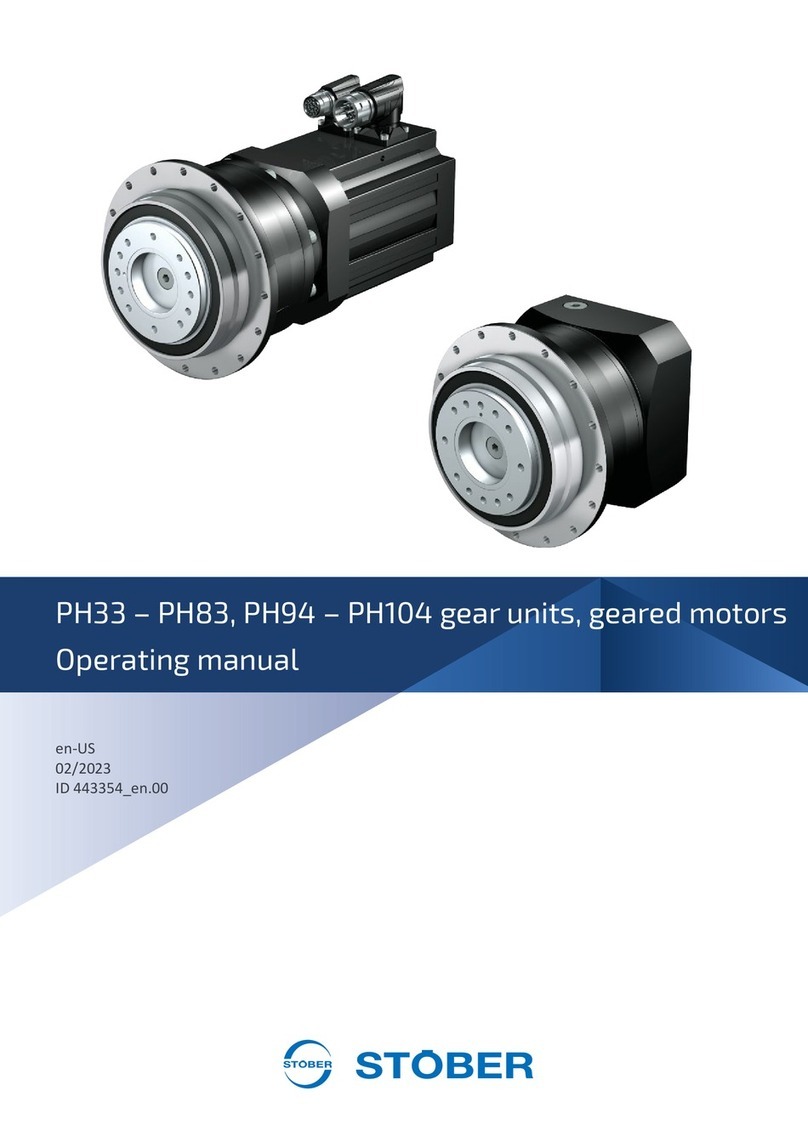
Stober
Stober PH104 User manual
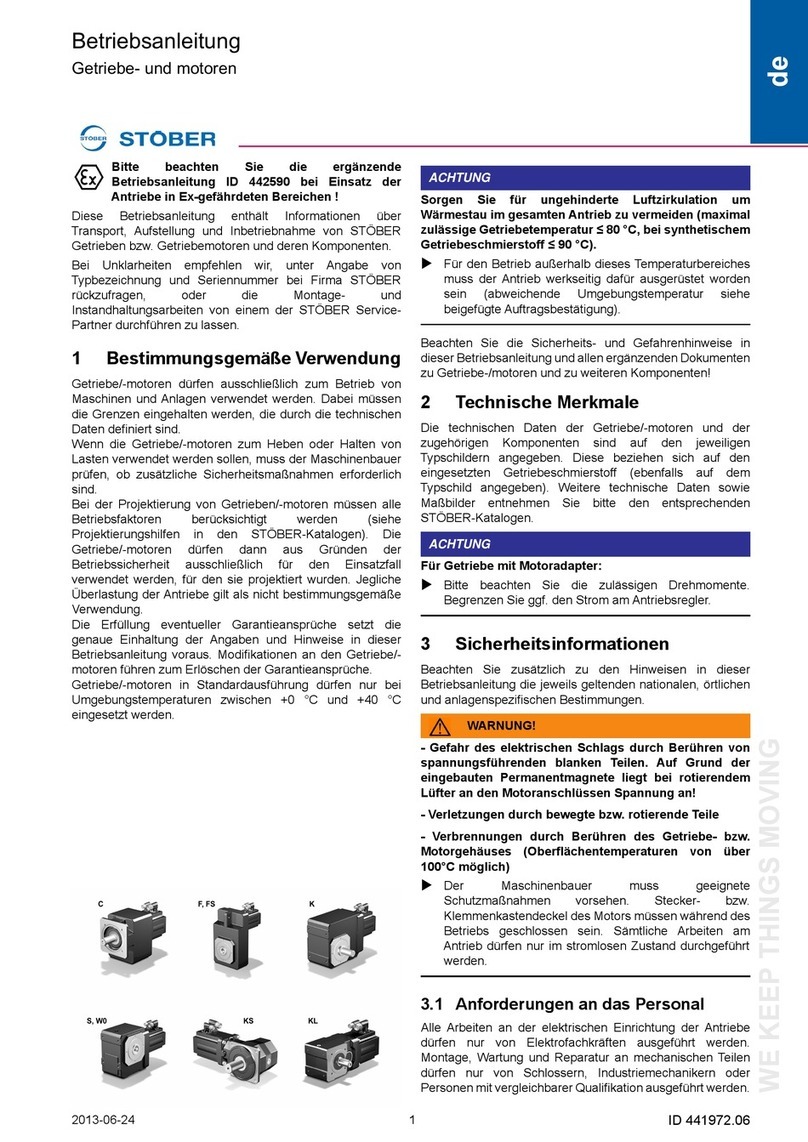
Stober
Stober KS Series User manual

Stober
Stober KL10 User manual

Stober
Stober P Series User manual
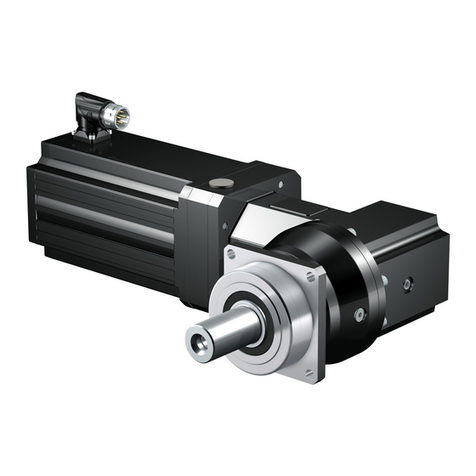
Stober
Stober PK Series User manual

Stober
Stober K1 User manual
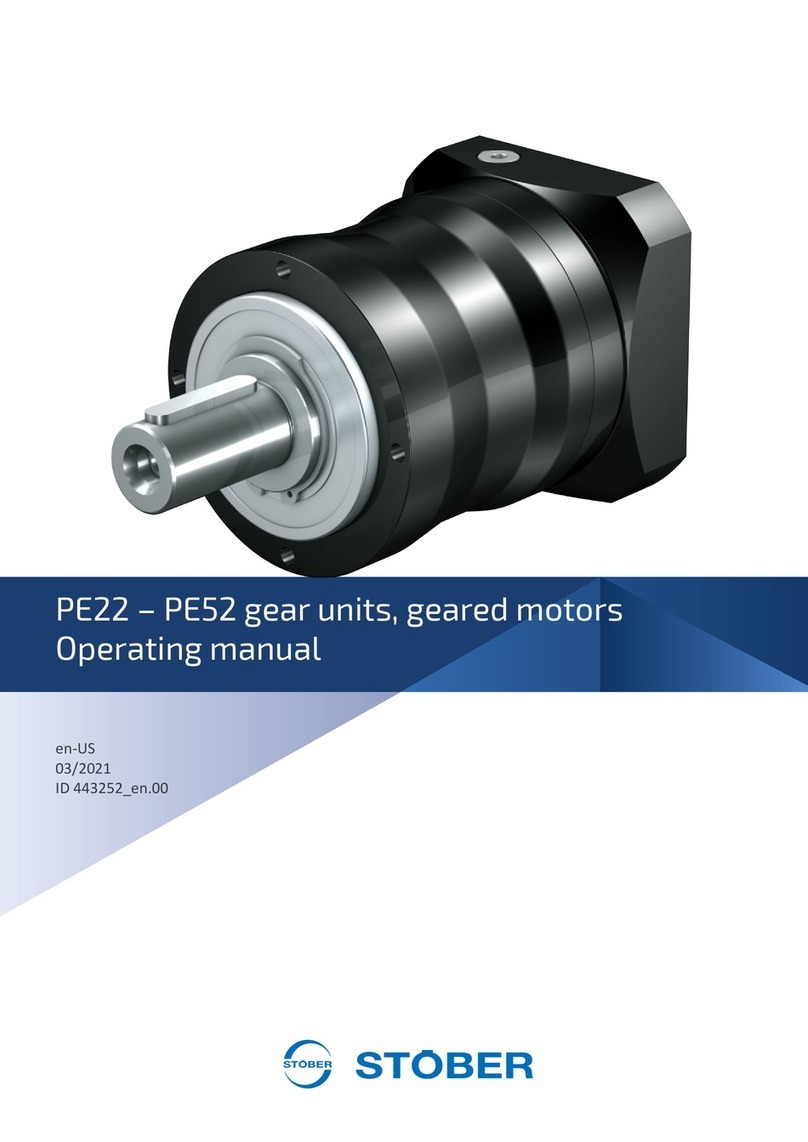
Stober
Stober PE22 User manual
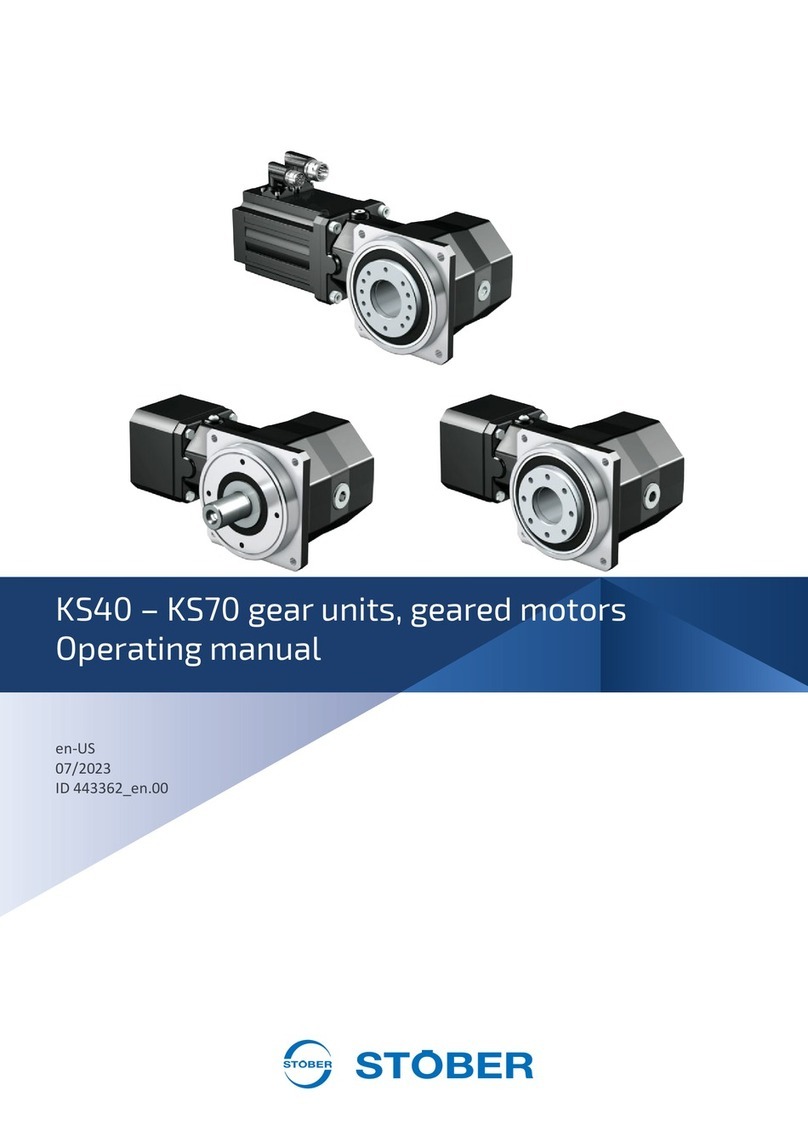
Stober
Stober KS40 User manual

Stober
Stober PHQ43KX User manual

Stober
Stober PHQ53K User manual




